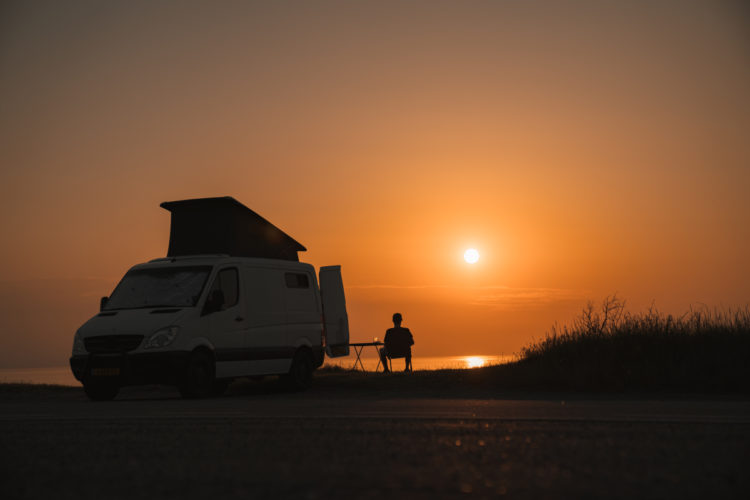
A lot of people think cooking with electricity is only an option at home, connected to the grid. After all, an electric cooker typically has its own dedicated circuit using 6mm cable and a 32A fuse, so cooking with electricity in a camper van is completely out of the question – right? No …it seems.
In this article part-time van lifers Shamira and Niels share their experience of induction cooking from battery.
Real-Life Road-Trial
At the time of writing – September – Shamira and Niels have been touring in Sweden for four weeks without visiting a campsite or plugging into the electricity grid. They have been cooking most days, spending most of their time parked up, and only driving for a couple of hours every 2 to 4 days. Their main source of battery recharge has been from their solar panels and they report that they are completely satisfied with their installation choices.
Shamira van Veenendaal is a 30 year old photographer and blogger, and her partner Niels de Graaf, 34, works as an IT network engineer. They live, work and travel part time with their cat Saartje in a DIY conversion van. It’s a compact Mercedes Sprinter with a 128″ wheelbase re-purposed with sustainable self-sufficiently in mind: solar panels, compost toilet, compressor refrigerator, diesel heater and – and as we are about to learn – an induction hob-cooker powered by their lithium-based Victron installation.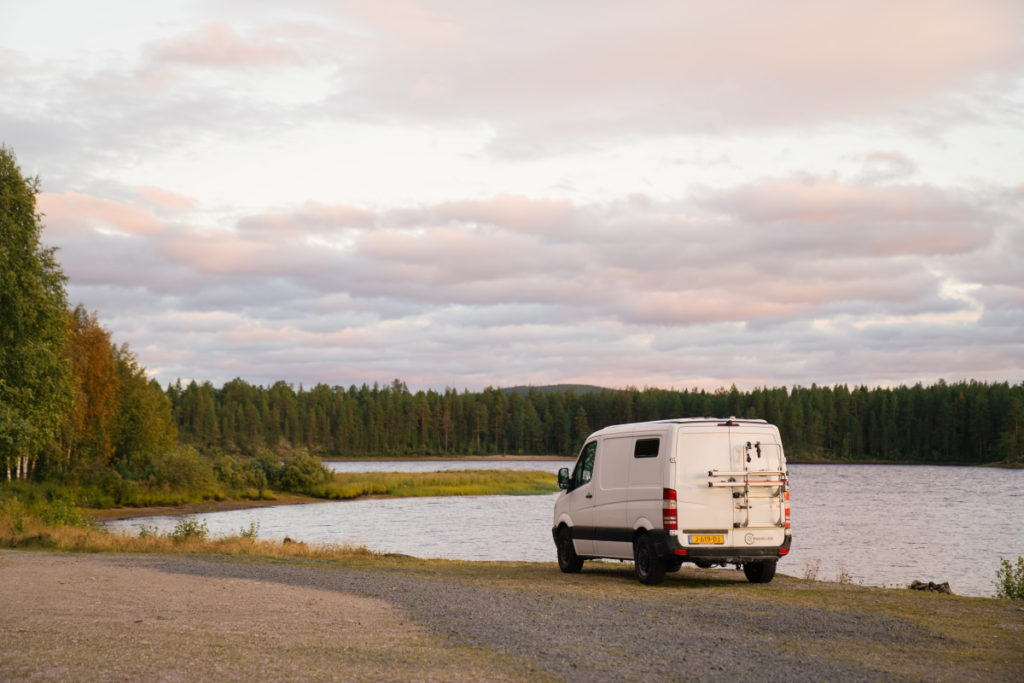
Induction on board
Gas is by far the most widely used fuel for cooking in a camper van; it’s cheap and easy to install. But for those who want to be independent of gas stockists induction cooking beckons. Electricity allows you to be completely self-sufficient; you no longer need space for a gas bottle; it’s safe, and it’s sustainable.
So why do so few choose ‘electric’ for cooking on-the-road? Is it because the complexity of charging and power provision need a bit more thinking through, because there is more initial expense; or because people don’t believe it can be successful, off-grid? Shamira says it was an interesting challenge, …but we can now say from our own experience that it is indeed possible and we are very happy with this option for cooking.
What is an Induction Hob?
From Wikipedia we learn: In an induction stove (or “induction hob”), a cooking vessel is placed on top of a coil of copper wire with an alternating electric current passing through it. The resulting oscillating magnetic field wirelessly induces an electrical current in the vessel. This large eddy current flowing through the resistance of the vessel results in resistive heating. The definition goes on to point out that the cooking vessel must be made from a ferrous material.
How much energy does an induction hob use in practise?
Shamira says: Many people who are interested in cooking on induction only look at the maximum power of the hob (usually about 3500 Watts) and conclude that it is not viable in a camper. However, this figure is based on two cooking zones on the highest setting at the same time. Nobody uses that, not even at home. We put it to the test by cooking a pasta meal for two. Pasta is a useful starting point because you have to boil a pan of water for ten minutes whilst cooking meat or vegetables on the other hob.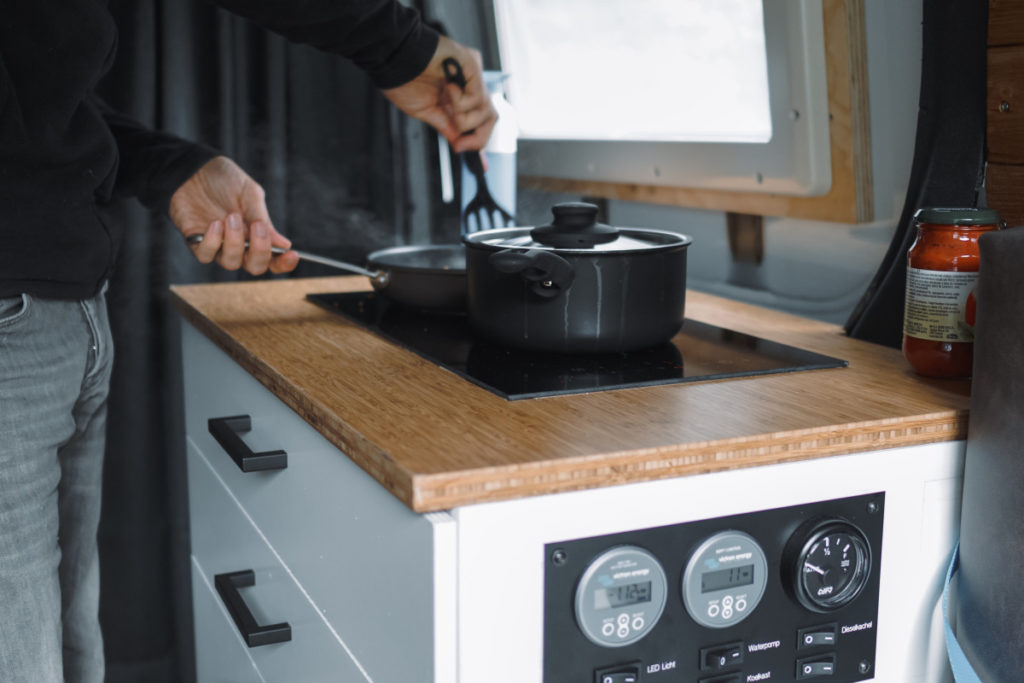
Experiment
“We brought 750 ml of water to the boil on speed 8, then let it boil for ten minutes on speed 5 and also baked some vegetable mince with red sauce on speed 6. The entire meal took about 25Ah of battery capacity (this also depends on the efficiency of the hob and pans, how much water you want to boil and whether you keep the lid on the pan when cooking for example) and the continuous power did not exceed 1600 Watts at its peak – most of the cooking draw less than 1200 watts.
At no stage did our food preparation approach even close to the maximum power of 3500 Watts. So you do not need a mega inverter of 3000 Watts or 5000 Watts. Our inverter is rated for a continuous power supply of 1600 Watts. We find it is more than enough. We can also use the coffee machine and small kettle on it which it handles really well.
General thoughts and observation regarding van life Lithium-based Induction
25Ah of battery capacity is of course quite something in such a short time, but most motor home owners do not cook every day. We regularly only warm up a soup or make wraps with vegetables where we only roast some pine nuts. This will draw considerably less power because you use fewer cooking zones and you don’t have to boil water …and keep it at the boil. Averaged over days, much less battery capacity is used on cooking than in our example.
In practice, it’s easy to recharge that 25Ah. And it’s good to know that a lithium battery can be discharged up to 90%. Suppose you cook such a pasta meal every day and therefore consume about 70A per day including all other electrical loads (refrigerator, lighting, charging laptop, etc.), then you can still get almost three days of autonomous power using a 200Ah lithium battery. That’s without recharging via solar panels or the dynamo while driving. If the sun is shining or if you are going for a drive, a lithium battery will recharge relatively quickly. They have a lower internal resistance during charging than lead batteries. Recharging the last 20% is particularly slow with lead batteries because of the increasing internal resistance (which means less current will flow). We have therefore opted for a 200Ah lithium battery.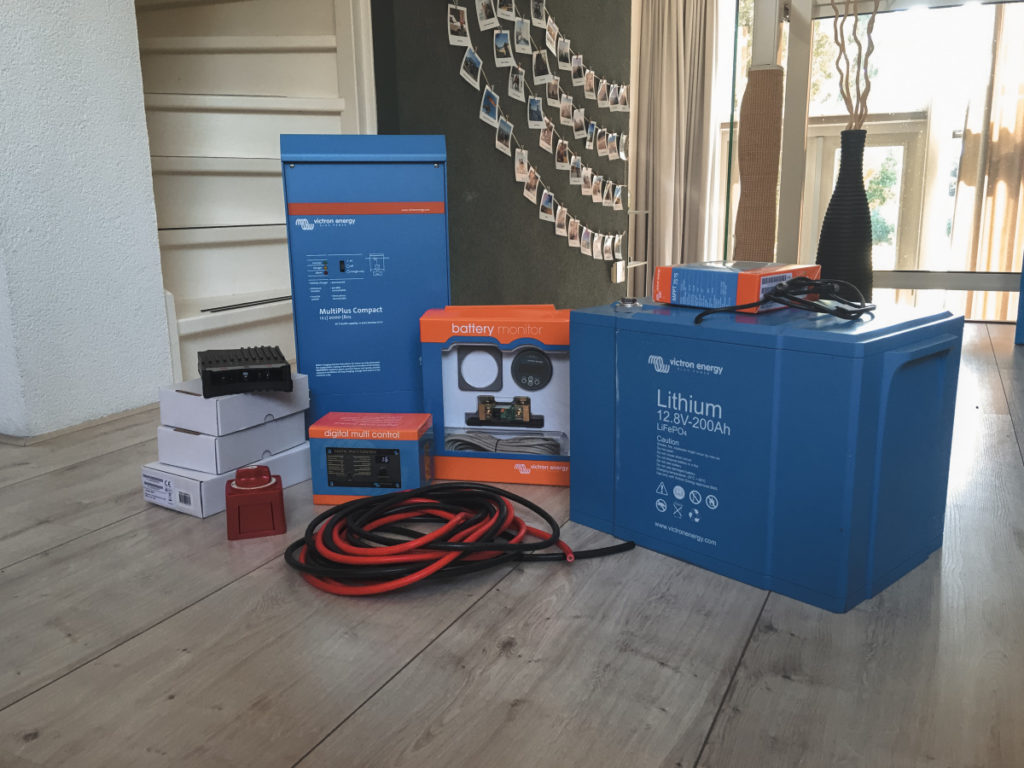
Electrical installation for induction cooking in the camper
The electrical set-up in a motorhome designed for cooking on induction looks a bit different due to the choice of a lithium battery. It becomes more complex and also more expensive. Below you will find everything you need to take into account with a lithium set-up, apart from the standard components that are usually present in a motorhome. Do you want to know product costs or where to order? We’ve listed all the products and other useful equipment for the camper on our webpage Wander Rebel – a link to which appears at the end of this article.
Main components
200Ah Lithium Battery: as you can see in the calculation, it is really not necessary to buy a few hundred Ah of lithium batteries. 200Ah is sufficient, but keep this as a minimum if you also want to be off-grid for a few days without adding power via the solar panels or charging via the dynamo while driving. Do you cook a little more extensively than we do or do you want to be free for longer? Then opt for more capacity.
BMS: The BMS is a special protection for lithium batteries. This checks the condition of the battery, mainly the cell voltage and temperature. The BMS can stop the battery charger (protecting it from overcharge) or switch off consumers (if the battery becomes too deeply drained). In addition, the BMS will prevent charging if the temperature is too low or too high, to prevent damage to the battery.
Battery Protect: a battery protect (battery guard) is an electrical switch that interrupts the connection between the battery and all electrical consumers such as lighting and the refrigerator as soon as the battery falls below a certain voltage. This is detected and communicated by the BMS. This prevents the lithium battery from being discharged too deeply. The battery protect stands on its own, but it is better to place it in combination with a BMV Monitor. This is very accurate, but it also gives you direct insight into the current battery statistics.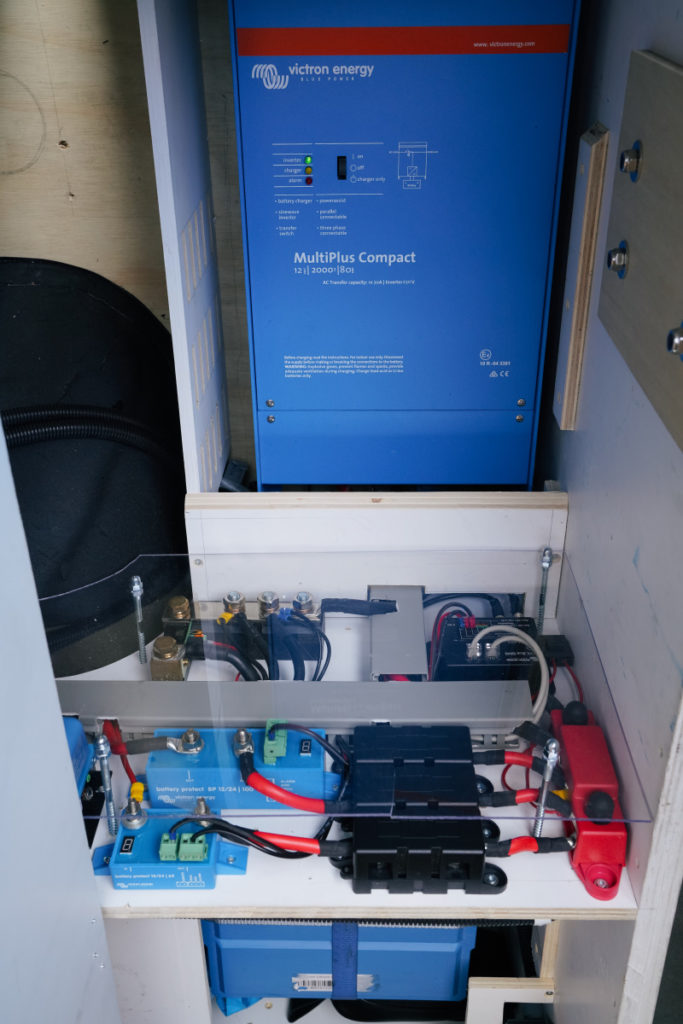
MPPT SmartSolar Charger: an MPPT solar charger maximises the power-harvest from a solar panel and stores it in the battery. The MPPT with bluetooth is more expensive, but the advantage is that you can also read the yield, system data and all kinds of other statistics of the panel on your smartphone via the free Victron app VictronConnect.
Solar panel: like many others we prefer to camp off-grid, but accept that sometimes that brings limitations. In bad weather or in winter, a panel produces less, while at the same time you often use more power. If you have the space and budget, certainly do it, but it is really not necessary to put 500+ Watts of solar panels on your roof to be able to cook on induction. We have 320 Watts. That’s modest, but we don’t need more. After all, we can be free for about three days on the battery alone and we can extend that via the alternator if we are driving. Even in March – when the sun is still quite low and weak – we can be off-grid with what we produce from the solar panel and the alternator if we’re driving.
DC/DC Converter: If, as is usually the case, you have two battery banks and want to charge the household battery via the vehicle’s dynamo while driving, you must install a battery combiner. This prevents the starter battery from being drained with the result that you can’t start the engine. However, if you use a lithium battery, you must install a dc/dc charger instead of a normal isolating relay. This prevents the alternator being overloaded by the battery; prevents the vehicle’s starter battery from being drained, and also prevents the lithium battery from being charged with too high (or low) voltages that can damage the battery.
Multiplus 12/2000/80 Inverter: As you can see in the calculation, an induction hob consumes quite a bit of power, but for the average camping meal, not nearly as much as the maximum power indicated in the product description. We have therefore opted for a Victron Multiplus 12/2000/80 with a continuous power of 1600 Watt. Do you cook more extensively than we do and do you want to be sure that your inverter meets the requirements? Then choose a Victron Multiplus 12/3000. The Multiplus series is useful anyway because it is an inverter and battery charger in one. It also works perfectly with the Victron Digital Multi Control.
Digital Multi Control: This panel is for switching the inverter on and off, but also very useful for setting the current limit between two AC power sources. For example, if the campsite power grid does not supply enough amps for your induction plate, you can indicate on the panel the maximum amperage the campsite does supply. During cooking, or whenever you turn on devices which exceed the power available from your hook up, supplemental power will be added by the Victron MultiPlus using a feature called PowerAssist. This way, even with a low current camping connections, you can still use larger devices in the motorhome.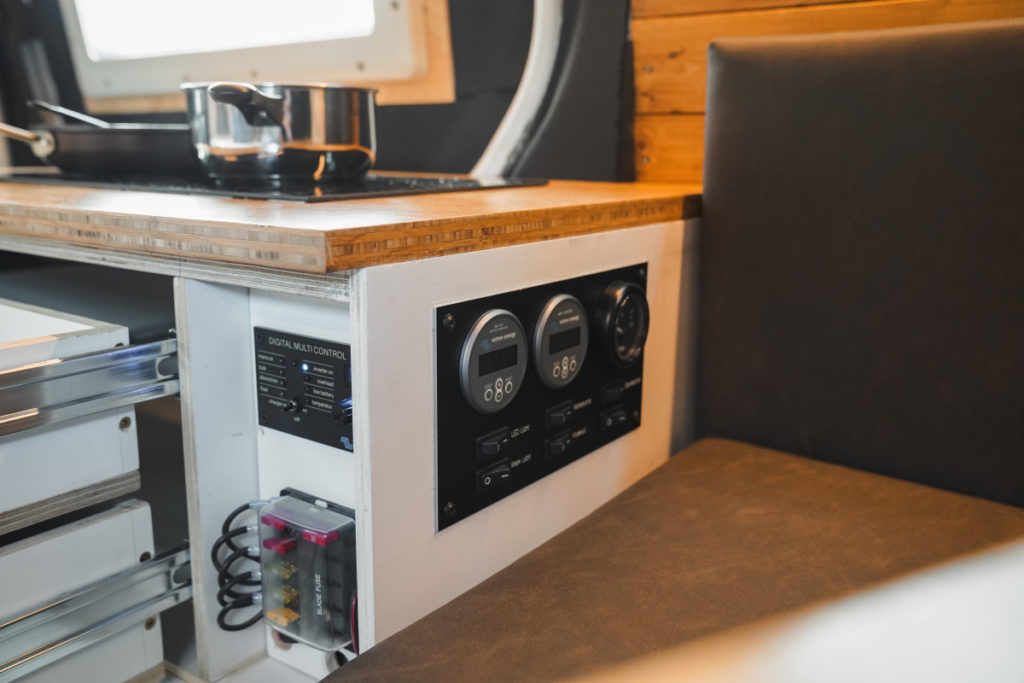
Cooking in the camper on induction with a lead battery
Electric cooking in the motorhome on induction is also possible with a lead-acid battery, but we do not recommend that. You have to take much more battery capacity with you compared to a lithium battery. This is because at large currents a lead (sulfuric acid) battery suffers from two phenomena.
- The total available battery capacity decreases as the discharge current increases, this is the Peukert Effect. The battery capacity specified by the manufacturer applies if you empty the battery in 20 hours. This means that a 100Ah battery is empty after 20 hours of supplying it. If you are going to increase the discharge current to more than 100A or even greater – because you are going to cook on induction – then the total battery capacity will be much lower.
- In addition, due to too high a discharge current a lot of heat is created and there is sulfation in a lead battery, both have a bad influence on the capacity and lifespan.
 If you still want to cook on induction with a lead-acid battery, then an AGM battery is most suitable for (short-term) high discharge currents. With lithium batteries, it is sufficient to look up the maximum discharge current allowed in the specifications to determine whether this is sufficient for cooking on induction. With a lead-acid battery, you would do well to limit the maximum discharge current to about 20% of the total battery capacity. If you want to cook on induction, you quickly need 1200 Watts to boil water (sometimes more in the peak), this is converted to 12 Volts, exactly 100 Amps. Assuming 20% maximum discharge current, you arrive at a battery capacity of 500Ah and that is the minimum to take with you. It’s possible, but it’s a bit of an exaggerated set-up for motorhomes. That is why most people opt for a lithium battery with this kind of power or capacity (also because it has up to five times more cycles). After all, two AGM batteries of 250Ah also require quite a bit of budget and you also add about 130 kg! to weight.
If you still want to cook on induction with a lead-acid battery, then an AGM battery is most suitable for (short-term) high discharge currents. With lithium batteries, it is sufficient to look up the maximum discharge current allowed in the specifications to determine whether this is sufficient for cooking on induction. With a lead-acid battery, you would do well to limit the maximum discharge current to about 20% of the total battery capacity. If you want to cook on induction, you quickly need 1200 Watts to boil water (sometimes more in the peak), this is converted to 12 Volts, exactly 100 Amps. Assuming 20% maximum discharge current, you arrive at a battery capacity of 500Ah and that is the minimum to take with you. It’s possible, but it’s a bit of an exaggerated set-up for motorhomes. That is why most people opt for a lithium battery with this kind of power or capacity (also because it has up to five times more cycles). After all, two AGM batteries of 250Ah also require quite a bit of budget and you also add about 130 kg! to weight.
Our plan to cook on induction in the camper was made possible in part by a collaboration with good advice from Stroomwinkel.nl.
You can learn more about life on the road and useful links to purchases at Shamira and Niels’ webpage Wander Rebel.
You can also follow Shamira and Niels on Instagram.






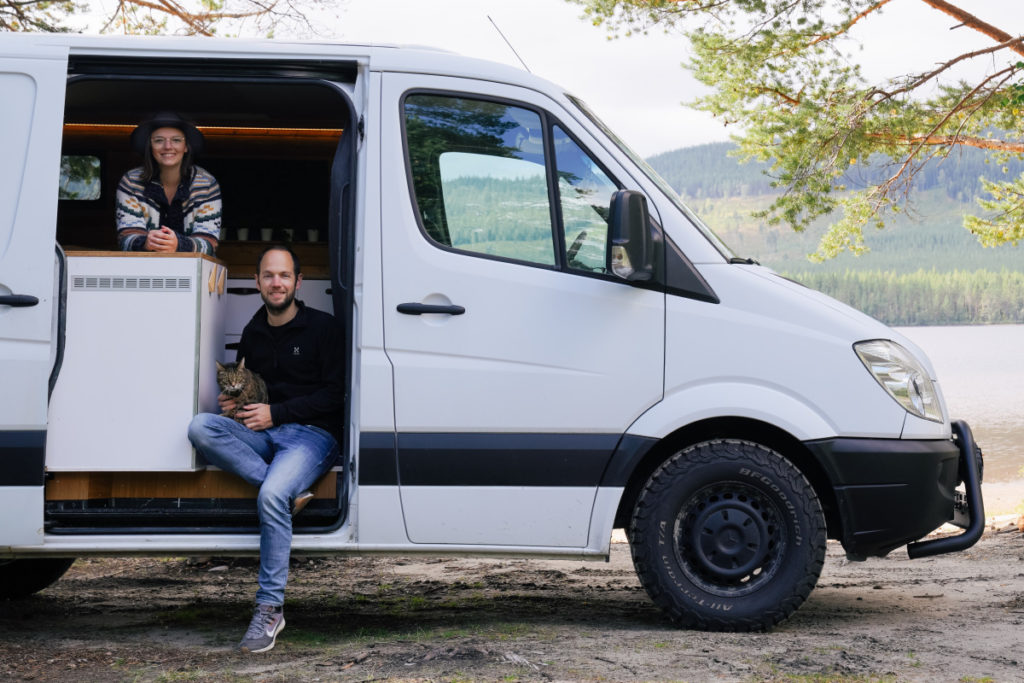












 #victronenergy #adventure
#victronenergy #adventure
 ELECTRICS
ELECTRICS 
